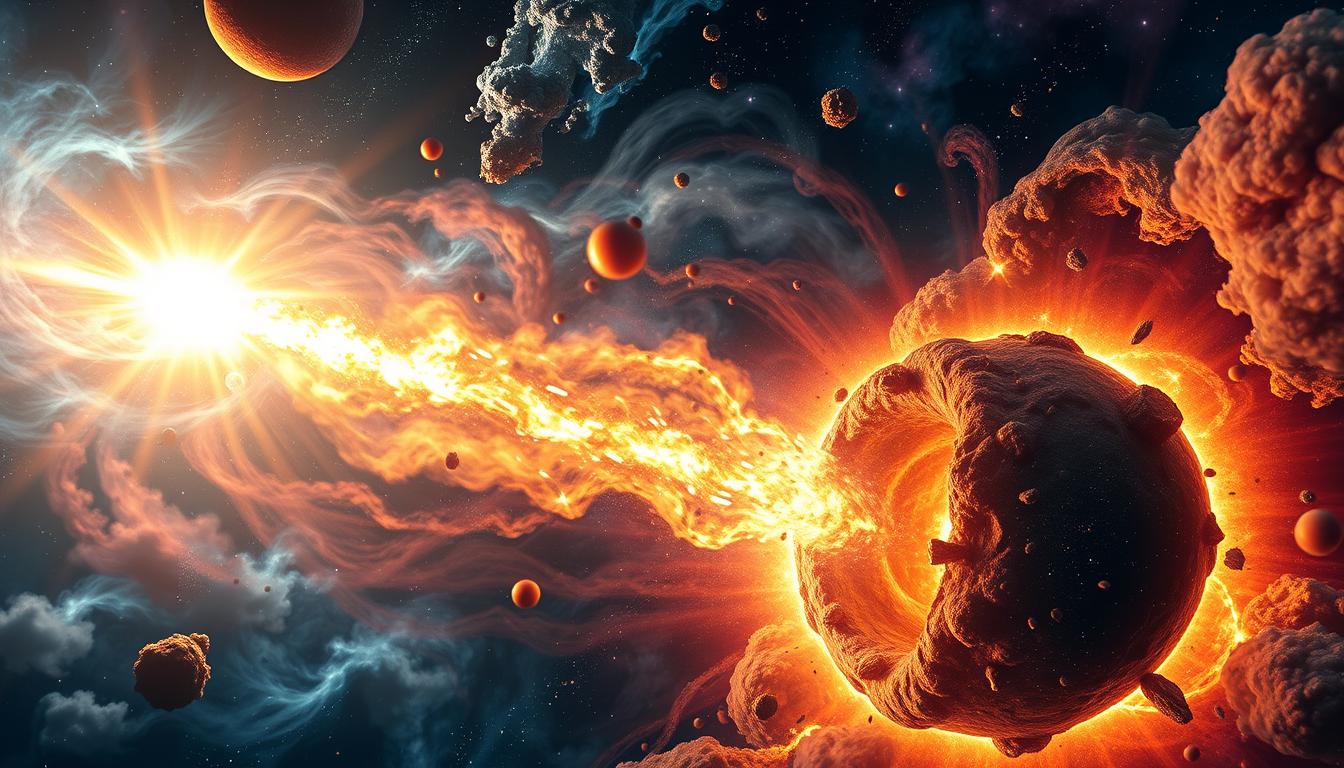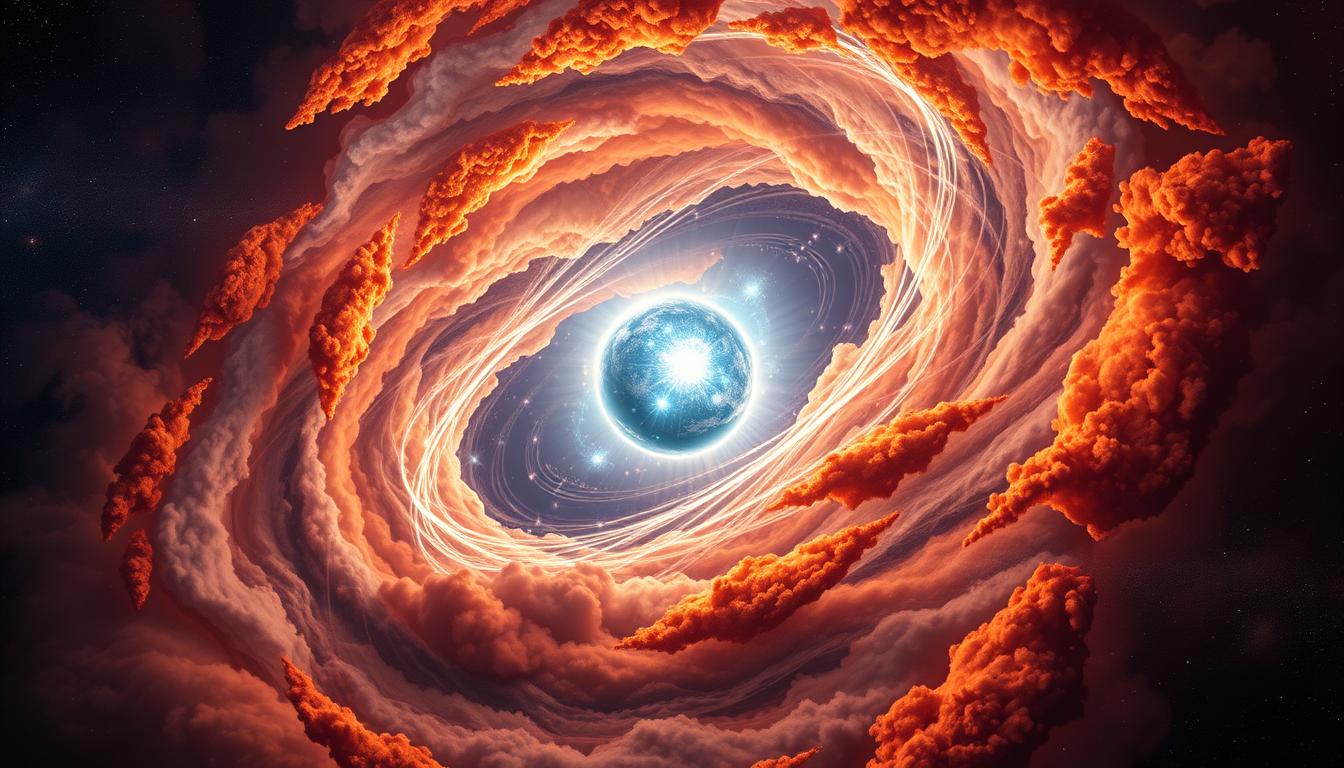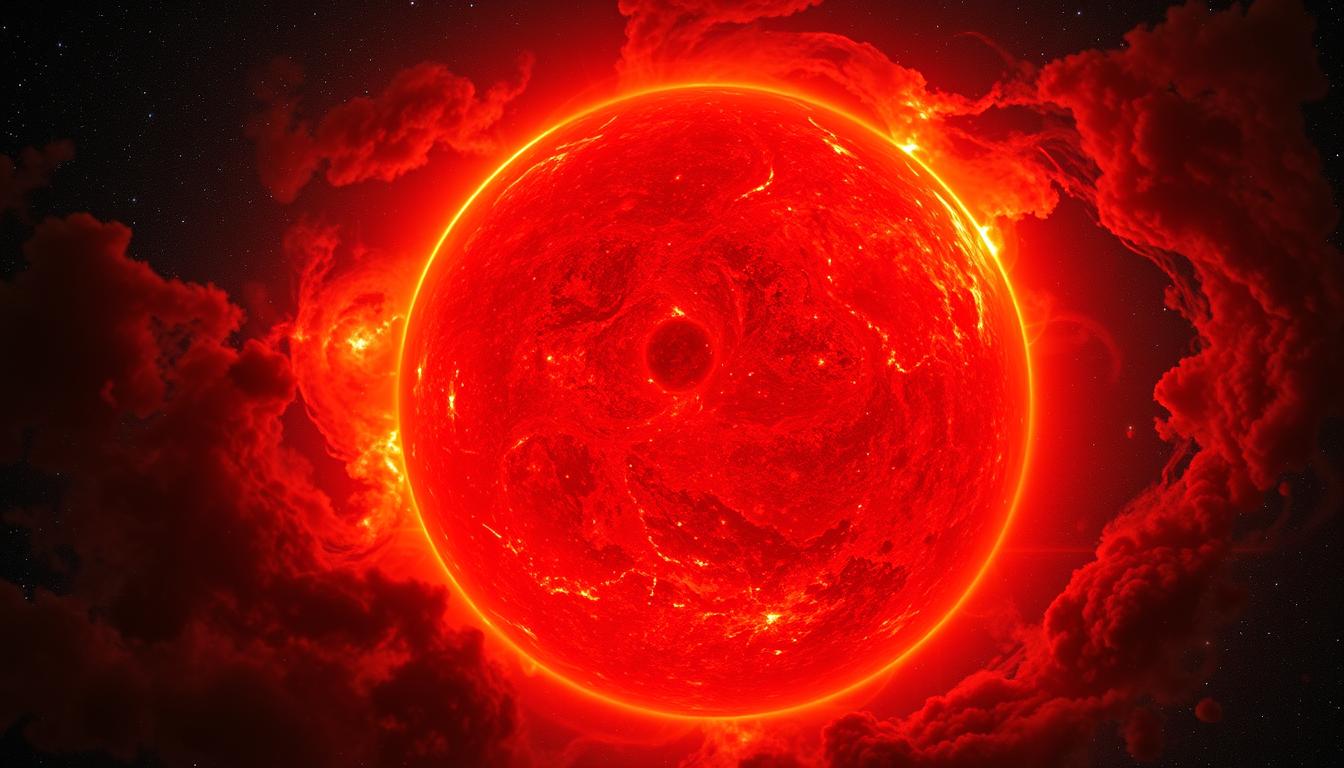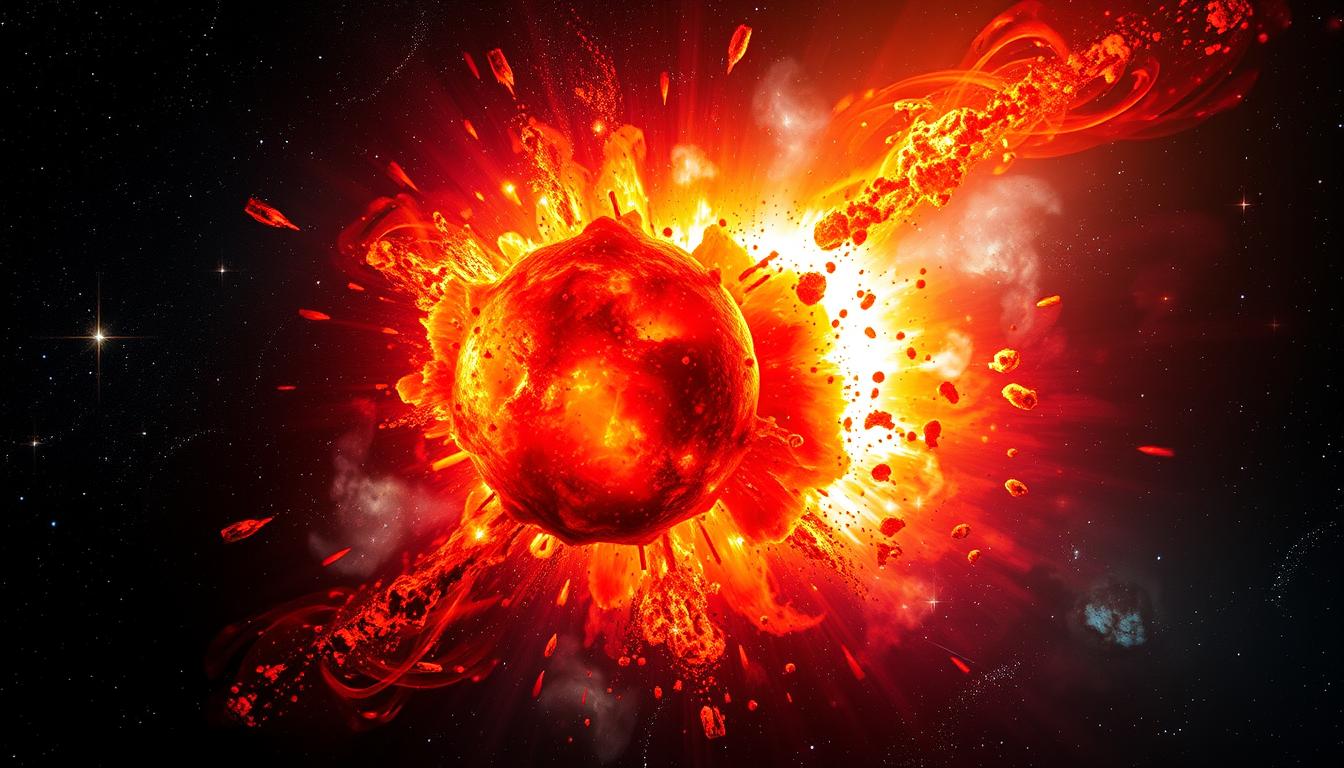Neutron stars are ridiculously dense and hot (see how hot they actually are in my article: here). Imagine cramming the entire Sun into a ball just 20 kilometers wide. That’s like squeezing a mountain into a sugar cube. A teaspoon of matter weighs as much as a billion tons. This isn’t science fiction but the world of neutron stars. Only about 10 kilometers wide, these cosmic giants have more mass than our Sun. But how does a neutron star form? Does it fit into what we know about physics?
Check out this article out, too: Is The Moon a Star? Our Satellite
It all starts with a star that’s a little too big for its own good. When massive stars reach the end of their life, they don’t just fade away—they explode. This explosion, called a supernova, is one of the most powerful events in the universe. What’s left behind? A tiny, super-dense core that becomes a neutron star.
Exploring how does a neutron star form gives us a really strong peek into a universe of gravity, nuclear physics, and the life cycle of stars from first-hand. Today, we believe there are about 1 billion neutron stars in our galaxy. Each one is a leftover from a massive star. These stars are not just interesting; they are also places where we can study physics in extreme conditions. We’ll dive into the life and (very dramatic) death of stars, what makes neutron stars so weird, and how neutron stars form.

Understanding Neutron Stars: The Basics
Neutron stars are the leftovers of massive stars that have exploded. They are like the universe’s ultimate leftovers, what’s left when a giant star explodes. They are incredibly dense, with a teaspoon of their material weighing about 10 million tons. Born from supernovae, they raise questions about their nature and uniqueness.
Imagine taking something the size of the Sun and squeezing it down until it’s smaller than a city but still somehow weighs the same. Yeah, the laws of physics get a little weird here. But before we start talking about how does a neutron form and it’s weird physics, let’s break it down. What is a neutron star, and why should we care?
What is a Neutron Star?
A neutron star is the collapsed core of a massive star. When a star at least 8 times the Sun’s mass reaches its life’s end, it explodes in a supernova. The outer layers get blasted into space, but the core? It gets crushed down into an ultra-dense, spinning ball of neutrons. The extreme pressure turns electrons and protons into neutrons, making them incredibly dense.
Think of it like this: If a regular star is a fluffy marshmallow, a neutron star is the same marshmallow after being run over by a steamroller a few million times. The gravity is insane—so strong that atoms themselves get squished, forcing protons and electrons to combine into neutrons. Boom! A neutron star is born.

General Properties of Neutron Stars
Neutron stars have a mass of about 500,000 times Earth’s and a gravity 1,000 billion times stronger. They are born hot, with temperatures around 1.8 million degrees Fahrenheit. Their magnetic fields are trillions of times stronger than Earth’s. See how this is where things get exciting? Let’s get into the fun stuff. Neutron stars are tiny but mighty, and they come with some crazy features:
- Super Small, Super Heavy – Only about 20 km (12 miles) wide but can weigh 1.4 times the mass of the Sun. That’s like cramming a mountain into a grain of rice.
- Spins Like a Maniac – Some neutron stars rotate hundreds of times per second. Imagine the Earth spinning that fast—goodbye, gravity!
- Ridiculous Gravity – The gravity of a neutron star is 2 billion times stronger than Earth’s. If you somehow landed on one, you’d instantly squished into a pancake.
- Magnetic Monsters – Some neutron stars have magnetic fields trillions of times stronger than Earth’s. If you got too close, your credit cards would stop working. (And, you know, you’d probably die.)
Stars’ Lifecycle Leading to Neutron Star Formation
Stars on their way to becoming neutron stars go through a fascinating journey. From their bright start to their explosive end, they pass through key stages. Before a neutron star is born, its parent star goes through that journey. Think of it like a celebrity’s career arc—starting out bright and full of energy, then aging into something massive and grand, before finally going out in a spectacular explosion.
Not every star can become a neutron star, though. So to learn how does a neutron star form, you must learn which stars can become neutron stars. Only the biggest, most massive stars (we’re talking at least 8 times about the mass of our Sun) get this honor. These stars live fast and die young, burning through their fuel in millions—not billions—of years. And when they reach the road’s end, things get interesting.
Main Sequence Stars
The journey starts in the main sequence phase. Here, stars like our Sun burn hydrogen to stay stable. This phase can last millions to billions of years. During this time, stars fuse hydrogen into helium. This process balances the star’s gravity, keeping it stable. Stars can start with masses from 0.1 to tens of solar masses.
This is a star’s “youth and adulthood.” The main sequence is a star’s longest and most stable phase. Our Sun is chilling in this phase right now, and it will be for a few more billion years. But for massive stars—the kind that ends up as neutron stars—this phase doesn’t last as long. They burn through their hydrogen fast, setting the stage for their eventual collapse.
The Red Supergiant Phase
When stars run out of hydrogen, they enter the red supergiant phase. It doesn’t just quietly fade away. They grow and cool, sometimes getting hundreds of times bigger. This is when they start making heavier elements in their cores. They fuse helium into carbon, oxygen, and iron. The iron core is important because iron fusion doesn’t release energy. This makes the star unstable.
Picture a star swelling up to hundreds of times its original size—if our Sun did this, it would eat Mercury, Venus, and maybe even Earth. Once iron starts forming, the star is doomed—fusion stops, gravity wins, and the core collapses. And that’s when the neutron star’s birth begins. As the core grows and gets denser, red supergiants reach a critical point. It collapses if the iron core’s mass is over 1.4 solar masses. This collapse leads to a supernova, where the outer layers are blown off.

How Does a Neutron Star Form During a Supernova?
Here’s where things go from “massive star” to “cosmic powerhouse.” When a star reaches the end of its life, it doesn’t just quietly fizzle out—it puts on one last explosive show: a supernova. This is one of the most violent events in the universe, outshining entire galaxies for a short period. That’s when the neutron star is born. During a supernova explosion, the core collapse mechanism plays a key role. A massive star, with more than 8 times the Sun’s mass, collapses at the end of its life. This collapse is driven by gravity, as the star loses energy from nuclear fusion.
Core Collapse Mechanism
The moment a massive star runs out of fuel, fusion stops. Without fusion, there’s nothing pushing outward to counteract gravity. So, gravity takes over, and the core collapses in on itself at incredible speeds. The core collapse starts with extreme pressure and temperature. The intense gravity compresses the core, raising temperatures to billions of degrees. This triggers fast nuclear reactions that can’t stop the collapse.
The outer layers are then ejected, leaving behind a dense core. This core is incredibly dense, similar to atomic nuclei. It stops collapsing, potentially forming a neutron star. The core must have a mass between 1.4 and 3 solar masses to form a neutron star. The pressure becomes so extreme that electrons and protons get crushed together, forming neutrons. This is why neutron stars are, well, made of neutrons. The core shrinks to the size of a city (about 10–15 miles across) but with more mass than our Sun. That’s some serious cosmic compression.
But the collapse triggers something even bigger.
Supernova Explosion
As the core implodes, the star’s outer layers come crashing down. But instead of just collapsing, they rebound off the newly formed neutron core. This creates an enormous shockwave. This shockwave tears through the star, launching its outer layers into space in a dazzling explosion. The result is a supernova. And what’s left behind is either a black hole or a neutron star. If the core isn’t massive enough to form a black hole, it stabilizes into a neutron star—one of the most extreme objects in existence.
What Happens After a Neutron Star is Born?
Alright, so a star has gone supernova, leaving behind a neutron star. Now what? Does it just sit there, looking cool and dense? Not quite. After a neutron star is born, it starts to cool and evolve. At first, these stars spin very fast, sometimes up to 50 times a second. But as they get older, they slow down. This slowing down is a key part of their evolution. Imagine taking an ice skater and making them spin on the ice. When they pull their arms in, they spin faster. Now, replace the ice skater with a dying star, and you’ve got a neutron star whirling around at speeds of up to 700 times per second. Some neutron stars, called pulsars, even beam out radio waves like interstellar lighthouses.
Even without fusion, neutron stars keep emitting electromagnetic radiation. This radiation is interesting when it lines up with our view. It lets us see these stars as pulsars, with their unique pulsating effect. Over time, cooling neutron stars might pull in matter from around them. This is more likely in binary systems, where they gain mass from a companion star. This extra mass can make them spin even faster, turning them into millisecond pulsars.

The Density and Composition of Neutron Stars
Let’s also briefly touch upon the neutron star density. This is what makes these stars interesting. These stars are born from massive stars, about 7 to 19 times the Sun’s mass. After a huge supernova, what’s left is a dense remnant. This doesn’t really fit into our understanding of physics. These things cram about 1.4 times the Sun’s mass into something just 10-20 kilometers wide. That’s like crushing Mount Everest into the size of a city block. This means a teaspoon of their matter would weigh a trillion kilograms on Earth. It’s the densest thing in the Universe, even denser than white dwarfs.
At their core, neutron stars are basically a giant atomic nucleus—except way denser. Their surface has a crust with nuclei and electrons. Deeper, the core becomes more neutron-rich, creating a solid core. Here, protons and electrons merge, making it a sea of neutrons, earning it the name “neutron star.” The outer crust is made of tightly packed atomic nuclei, while the inner core is… well, we’re not entirely sure. Some theories suggest it could be filled with exotic particles or even a weird state of matter called quark-gluon plasma. This is an area scientists are studying, but much is unknown.
Neutron Stars in Binary Systems
Neutron stars don’t always fly solo. Some of them are locked in binary systems with a regular star, another neutron star, or even a black hole. Most stars live with a partner, with 60-80% having a companion. This means many neutron stars have a pair.
Take X-ray binaries, for example. In these systems, a neutron star steals material from its companion star, heating it up to millions of degrees and blasting out powerful X-rays. These are some of the brightest objects in the sky. These systems come in different shapes. For example, Hercules X-1 orbits a star twice as massive as our Sun. The stars move fast in these close systems. Some neutron stars spin so quickly that they flash light 100 times a second.
Neutron stars in binary systems also create gravitational waves. The 2017 LIGO discovery of gravitational waves from a neutron star merger was a big deal. Systems like the double pulsar that we discovered in 2004 will also show how these stars will eventually merge.
Conclusion
So, there you have it—the epic story of how does a neutron star form and what happens after. From the fiery death of a massive star to the birth of one of the densest objects in the universe, neutron stars are nature’s way of showing off. Neutron stars are a window into the universe’s secrets. They form in supernovae explosions and have densities of about 1014 g/cm3. Imagine a pulsar in the Crab Nebula, pulsing 30 times a second with energy far beyond our Sun’s. They spin like crazy, beam out radio waves, and sometimes crash into each other, sending ripples through spacetime (and maybe even sprinkling gold into the cosmos).
But the coolest part? We’re still figuring them out. These stars are key to understanding extreme physics. They are like natural labs for studying the universe’s most extreme conditions.
FAQ
How does a neutron star form?
A neutron star forms from a massive star’s collapse after a supernova. This collapse compresses the core to an extreme density. It’s denser than a white dwarf and almost as dense as atomic nuclei.
What is a neutron star?
A neutron star is the core of a massive star, shrunk to about 10 kilometers in radius. It has a mass similar to the Sun’s but is incredibly dense. This density causes electrons and protons to merge into neutrons under intense pressure.
What happens during the red supergiant phase?
In the red supergiant phase, a star expands and fuses heavier elements in its core. The core’s mass grows until it can’t support the star’s gravity. This leads to a collapse and a supernova explosion.
What happens after a neutron star is born?
After birth, neutron stars cool and slow their rotation over time. They may emit radiation, observable as pulsars, if their magnetic and rotation axes are misaligned. In binary systems, they can gain mass from companion stars, altering their evolution.
What is the density and composition of neutron stars?
Neutron stars are nearly all neutrons due to their high density and pressure. The outer crust has nuclei and electrons, transitioning to more neutron-rich layers inward. Their density is so extreme that a matchbox of neutron-star material would weigh about 3 billion tonnes.